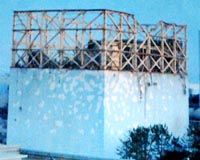| . |  |
. |
Tokyo (AFP) March 17, 2011 Japanese military helicopters dumped tonnes of water Thursday onto the stricken Fukushima nuclear power plant northeast of Tokyo in a bid to douse fuel rods and prevent a disastrous radiation release. Four twin-rotor CH-47 Chinooks of the Self-Defence Forces ran the first mission to empty large buckets that hold more than seven tonnes of water each onto the facility damaged by Friday's massive earthquake and tsunami. The operation aims to keep the fuel rods inside reactors and containment pools submerged under water, to stop them from degrading when they are exposed to air and emitting dangerous radioactive material. The helicopter mission started in the morning under a clear sky after a similar effort the previous day was called off shortly before darkness fell by officials citing strong radiation and high winds. Police water cannon were also set to support the effort Thursday in addition to equipment already in use over recent days at the plant, some 250 kilometres (155 miles) northeast of the Japanese capital. Defence Minister Toshimi Kitazawa said an additional 11 military vehicles would be deployed for efforts to help cool the reactors, while pumps supplied by the US armed forces were also being transferred. The government's nuclear safety agency has said the top priority should be pouring water into the fuel-rod pools at reactors three and four, which may be boiling and are not fully covered by roofs that would reduce radiation leaks. An official at plant operator Tokyo Electric Power Co (TEPCO) said Thursday the pool at the number-four reactor "seemed to have water" on Wednesday, based on aerial observations carried out by the military helicopters. Another TEPCO spokesman said: "We have not confirmed how much water was left inside but we have not had information that spent fuel rods are exposed." TEPCO said earlier it was concentrating on restoring the power supply to reactivate its crippled cooling systems, which were knocked out in the dual calamity that hit Japan. "We cannot tell when, but we want to restore the power source as soon as possible," TEPCO spokesman Naohiro Omura told AFP. TEPCO was preparing to restore outside power lines from Tohoku Electric Power Co., which serves the region, and connect its damaged electric transmission system with unaffected lines. "At the moment, we are concentrating our efforts on this work," the spokesman said. "If the restoration work is completed, we will be able to activate various electric pumps and pour water into reactors and pools for spent nuclear fuel." The 9.0-magnitude quake, the biggest on record to strike Japan, knocked down electricity pylons which Tohoku had used to supply power to the TEPCO plant. Some 70 workers have been using pumps to pour seawater to cool reactors at the plant, according to media reports, using electricity from borrowed mobile generators. In Fukushima prefecture, where a zone within 20 kilometres of the plant has already been evacuated, about 10,000 people were to be screened at 26 locations for radiation exposure, Kyodo News reported, citing local officials. So far, radioactivity was detected on six people, whose faces and hands were wiped clean, the report said.
earlier related report
Share This Article With Planet Earth
Related Links Bringing Order To A World Of Disasters A world of storm and tempest When the Earth Quakes
 Workers try to restore power at Japan nuclear plant
Workers try to restore power at Japan nuclear plantSendai, Japan (AFP) March 17, 2011 Japanese engineers were Thursday focusing their efforts on restoring the power supply to a quake-damaged nuclear plant in an attempt to reactivate its cooling system and avert a meltdown. Last Friday's massive earthquake and tsunami knocked out the power supply and back-up generators at the Fukushima No. 1 plant on the Pacific coast, some 250 kilometres (155 miles) northeast of Tokyo. Th ... read more |
|
| The content herein, unless otherwise known to be public domain, are Copyright 1995-2010 - SpaceDaily. AFP and UPI Wire Stories are copyright Agence France-Presse and United Press International. ESA Portal Reports are copyright European Space Agency. All NASA sourced material is public domain. Additional copyrights may apply in whole or part to other bona fide parties. Advertising does not imply endorsement,agreement or approval of any opinions, statements or information provided by SpaceDaily on any Web page published or hosted by SpaceDaily. Privacy Statement |